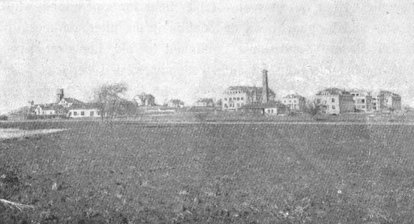
The American College at Sofia
CHAPTER XIX
American uplifters
Bulgaria of course has not been overlooked by the uplifters. They picked her out as a favorable field for operations while she was still a "poor benighted nation in the utter darkness of Turkish slavery" and have continued to aid her ever since, rendering her very useful and well appreciated services. The principal habitats of these apostles, who leave their homes and relatives to bring what they consider the blessings of Western Civilization to a patriarchal land of retarded people, are Italy, France, Germany and America. The English, also, are uplifting Bulgaria a little but they do their bit in occasional jerks rather than in long steady pulls, reserving their main efforts to lands in direr plight.
Of course, enlightened and advanced nations have not made the necessary sacrifices to open and maintain large and expensive uplift institutions in far off Bulgaria merely for the sake of somebody's bewitching black eyes. The givers think they are serving national or religious causes; they have set out to draw Bulgarians into German, French or Italian camps or else Orthodox Christians into Protestant and Catholic folds. In all these crusades the knights are perfectly conscientious — to which I can testify, having been one of them — and they so ardently believe they are doing Bulgaria a service by bringing her under German, French, Italian, Catholic and Protestant influences that they joyfully give their lives to the cause.
And they are essentially right in their convictions. Bulgaria is without question the gainer for letting herself become the object of this missionary activity. The yearly reports which the crusaders send back to their home boards or governments. plainly show that the favorable balance is all on Bulgaria's side.. Not many of the folks being uplifted really become Fascists,. Protestants, Catholics or ardent French sympathizers, but they are enabled to get some very helpful culture from the West and to come in close contact with idealistic and noble people. Bulgaria has done well to let foreigners work upon her. She doesn't want too many of them and is now on the point of preventing her children from going to foreign schools before they reach the age of fourteen but, from the first high school class up, well conducted foreign schools are welcome. Generally speaking, Bulgaria is marked by her toleration of private schools in non-Bulgarian languages. Every minority group is allowed its own institutions, the Turks alone having 800.

The American College at Sofia
Of the foreign schools in Bulgaria the American are certainly among the best and, as conducted at present, are without question the most disinterested. Practically every one of them has now given-up trying to make Protestants, while they have never been tainted b/ the slightest tendency toward nationalistic propaganda, so they exist exclusively to work for the good of the country as they understand it. All the Americans working in these schools are wholeheartedly devoted to the land they have left home to serve and aim at nothing else than to make the Bulgarians more efficient, prosperous and noble people.
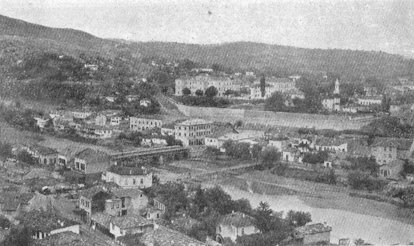
The cluster of buildings in the upper part of the picture
is the American Girls' School at Lovetch
The relations between the American uplifters and both official and unofficial Bulgarians have almost always been of the very best. In certain critical moments a number of Americans have rendered Bulgaria very important political services, while, in addition to this, the Americans crusading in the country have been without exception men and women of high character and unusual devotion, occasionally even of marked ability, so they have given America an honored name. In practically every instance they have acquired the deepest love for Bulgaria and her people and have always looked upon themselves as humble guides trying to aid their newly adopted brothers and sisters along the difficult road to progress. In consequence relations among uplifted and uplifters have been very intimate and cordial, the Americans often showing even more faith in the Bulgarians than they have in themselves.
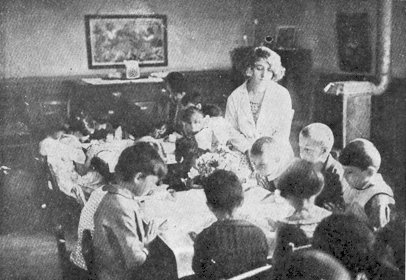
The children in the American Kindergarten bless their
morning lunch
The oldest American school, as well as the largest, the best equipped and the best conducted, is the American College of Sofia. It, or at least one of the institutions from which it originated, was founded in 1860 by missionaries of the American Board. It was situated at first in the city of Philippopolis and was attended by a small number of poor boys, all of whom it was hoped would become Protestant preachers or propagandists and many of whom did. A girls' school with a somewhat similar purpose was founded three years later in the city of Stara Zagora and was one of the very first boarding schools ever opened for Bulgarian girls. This was nearly two decades before Bulgaria was freed from Turkey and these two American institutions, along with a fairly large number of American elementary schools for Protestant children, took a very creditable part in .bringing enlightenment to an awakening nation. Later both the Girls' and Boys' Schools were moved to the city of Samokov in southwestern Bulgaria, raised to the rank of Gymnasiums or Junior Colleges and given official recognition by the state. In the half century of their development they largely ceased to be agencies for recruiting Protestants and came to be attended predominantly by Orthodox children, whose parents wanted to give them a good education under wholesome influences.
Wouldn't it be nice if washing dishes was always as much
fun as it is for these children in the American Kindergarten
At the close of the World War the Mission Boards decided to move the schools to Sofia, the capital, and for that purpose bought 160 acres of land, beautifully situated near the foot of Mount Vitosha about five miles out of town. Eventually the two institutions were united under the name of the Sofia American Schools, popularly known as the American College, and all properties belonging to them were handed over to a new Board of Trustees, who live in America and who had the new organization chartered by the state of Massachusetts for carrying on educational work in Bulgaria. In June 1926 the College became a member of the Near East College Association, whose headquarters are in the city of New York.
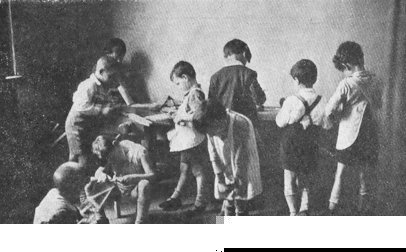
Busy hands keep out of mischief
Less than a year after that the construction of buildings for the new institution was begun and in the course of four years twenty-one were finished. The College plant includes living quarters for 450 students, class rooms, laboratories, library, manual training shops and recreation rooms, as well as living accomodations for fifty members of the staff. All the buildings have been constructed by Bulgarian architects and craftsmen, employing, so far as possible, materials produced within the country. The furniture has been manufactured in the College shops. The campus consists of forty acres of land providing ample facilities for outdoor sports.
The College enrollment is almost equally divided between boys and girls. The curriculum covers six years, including two preparatory forms and four college classes. New students are admitted only into the first preparatory form and that by examination, after they have finished a national progymnasium or its equivalent. The average age of students entering the Freshman class is sixteen years and six months. The course ,of study is organized in such a way as to fit into the educational system of Bulgaria. The diplomas of the College are generally recognized by European universities, which admit graduates to professional work without examination.
The institution is supported largely by the students; their fees account for 70% of the total cost of operation while the rest comes from interest on endowment. All the students are boarders and the fees for one year total 152 dollars, which covers the cost of board, room, laundry, text books and tuition. The financial assets of the College amount to approximately one million dollars of which one half is endowment.
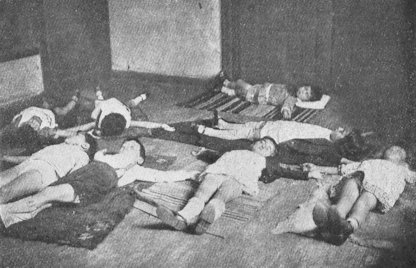
Nap time in the American Kindergarten but I don't believe
they're really asleep
Practically all of the students are Bulgarian citizens. Since the number of applicants is very large the ones received are selected with great care and constitute what is in many respects the most competent and promising student body in the country. The aim of the College is to give Christian culture and it emphasizes intellectual training, healthful living and development of character. It offers to a choice body of Bulgarian boys and girls the best general secondary education provided any place in the land.
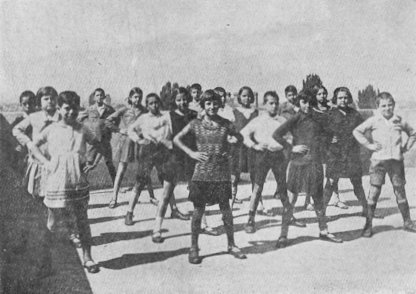
A class in the American Grade School at morning drill
The only other American educational institution of high school rank in Bulgaria is the Girls' School in northern Bulgaria, founded and maintained by the Woman's Foreign Missionary Society of the Methodist Church. It was opened in 1890 on a hill overlooking the picturesque mountain town of Lovetch and was at first designed to provide education for Protestant girls only. However, in the course of time it became known for the excellent care and training it gave to the pupils entrusted to it so was more and more sought by girls from the Orthodox faith, even, indeed, by the daughters of priests. This necessitated a frequent extension of the plant and the putting up of new buildings, so that it has become one of the largest girls' boarding schools in the land and is always filled to capacity. Its diplomas are recognized by the government and its graduates are able to enter the State University without hindrance.
The fees for board, room and tuition come to eighty-six dollars and fifty-four cents a year. All the girls in the school are required to do some house work daily as part of their regular training and those without means are enabled to earn a portion of their tuition. The students, over 200 in number, come from all parts of the country, representing all social classes — so far as there are classes in Bulgaria — and are taught to live together as a family, sharing duties, joys and responsibilities. The school is marked by very intimate and friendly relations between teachers and pupils and although a high standard of scholarship is maintained the chief efforts of the faculty are directed toward inspiring the girls to perform some useful service in their home towns and villages. The institution is fortunate in having a staff of young, energetic and devoted American teachers who have completely identified themselves with the pupils in the midst of whom they live. Friendship, unstinted service and mutual confidence are the moving forces in the life of the school and are the chief factors in the realization of the aims of those who maintain it, namely to inculcate higher ideals of love, service, cleanliness and efficient, happy living. About 30 girls graduate yearly after completing a course similar to that of a junior college in America.
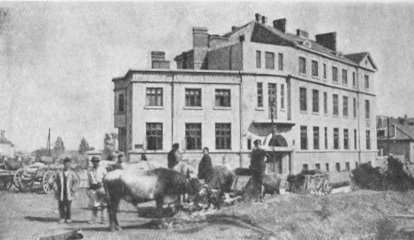
The uncompleted building in which the American Grade
School is housed
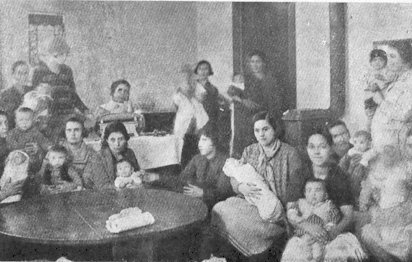
In the American Community Center. Swaddled babies look
like human cocoons and are as easy to handle as any other package
The American Kindergarten in Sofia, founded in 1900, was one of the first in the country and the training school for kindergarten teachers connected with it, which was also a pioneer institution, continues to be the only first class normal school in Bulgaria, providing a complete and efficient kindergarten training course. It is still conducted by Miss Elizabeth C. Clarke, its founder, an American missionary, who has succeeded in keeping it going and brought it up to its present high state of efficiency only by dint of great personal sacrifices. But she has had the joy of seeing the kindergarten idea accepted by practically the whole nation and kindergartens opened in all parts of the country, the best trained teachers for which her institution is supplying. She employs only the best American methods and has entrusted much of the work in the training school to an able Bulgarian young woman who has finished the course for kindergarten teachers at Northwestern University, Evanston, Illinois, and who is invited by women's societies in all parts of the country to give addresses on child training. There are fifty students taking the two years course, half of whom are in the boarding department. The normal school is to be taken over by the Bulgarian government and made a regular part of the state educational system.
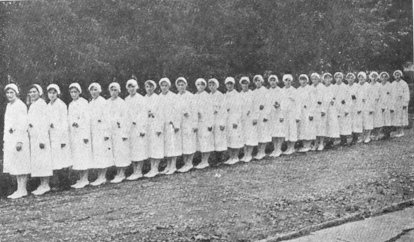
The girls in the Red Cross Nurses' Training School have
to walk the straight and narrow
The American Grade School, which was opened in Sofia in 1922, was, in a way, an outgrowth of the American kindergarten and was founded to complete the American educational system in Bulgaria, which now takes children from the kindergarten clear up through Junior College. The School began with an enrollment of 12 and now has 190. It gives its pupils a surprisingly good working knowledge of the English language but does not neglect Bulgarian. It lays chief stress on character training and strives to inspire in the children attending its seven years course a practical and effective devotion to their country. Four of its twelve teachers are Americans and most of the rest from American institutions.
This school also serves as a center of social activity and the building in which it is housed is Sofia's first Community Center, created by a number of American missionaries. When the edifice is completed and the enterprise fully developed it will carry on five kinds of social activities: education, health, employment, recreation and protection of young women. The land for the plant was given by the city government of Sofia and the building will consist of three spacious floors, in addition to a high basement and an attic. This is the most extensive attempt at disinterested social service that has yet been made in Bulgaria, although of course local philanthropic societies do many very helpful things.
Another useful educational institution, which, although not founded nor maintained by Americans, has received very vital aid from America, is the Bulgarian Red Cross School for Training Nurses, which has existed since 1900. It was completely reorganised in 1914 by Queen Eleonora under the direction of two distinguished and competent American nurses. Miss Helen Scott Hay and Miss Rachel C. Torrence, who were sent to Bulgaria and supported there by the American Red Cross. Another very efficient American nurse. Miss Hazel Goff, also rendered the school excellent service as its director. When she retired in 1927 the management was taken over by the Bulgarians themselves and entrusted to a native young woman who after finishing the American Girls' School in Samokov had made a special study of nursing in the United States, which she frequently visits. She is maintaining the high standard of order and efficiency established by her American predecessors and keeps her institution in the ranks of the best in Bulgaria. The course is of three years duration and includes a great deal of practical work. There are 74 students enrolled. 356 nurses have graduated, most of whom are in active service, in various parts of the country.
The latest American educational institution is the Folk School in the village of Pordim, in northern Bulgaria, and it represents a new kind of uplift work. It is unquestionably one of the most hopeful educational enterprises to be found anywhere in the Near East, because it is endeavoring to give the people most in need of enlightenment just the kind of enlightenment they are most in need of.
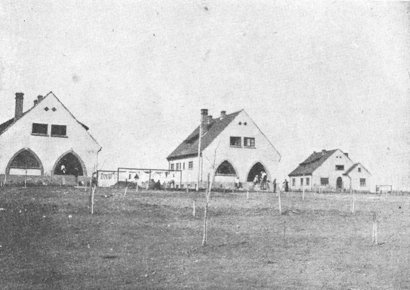
The American Folk School in the village of Pordim
This school is exclusively for village youth and its one aim is to teach them how to live happier and more prosperously in the village. It is not part of a general educational system, giving diplomas that enable peasants to graduate up into city life; it is not a round in a ladder of certificates lifting bright boys and girls out of drab villages. On the contrary, it is designed to be a lever, lifting the whole village up. It avoids bureaucracy and eschews all that seems academic, which does not mean, of course, that it hasn't high standards. It has, indeed, very high standards and seeks to make its pupils experts, but experts in the things directly affecting village life. There is nothing improvised or haphazard about its ideals, no feeling that anything less than the choicest is good enough for peasant clodhoppers. Just the opposite! It endeavors to give the very best-but, that sort of best which will transform village life, and rightly, since most Bulgarians pass their life in villages. The future of the country depends on the villagers. By far the most fundamental and implacably urgent problem connected with the social, economic and political development of Bulgaria is the preparation of the peasants to play the dominant r6Ie that falls lo them. The villagers are eventually going to take into their hands Bulgaria's business, governmental and cultural machine and the vital question is will they know how to run it or will they smash it, because of their ignorance. Every other problem is of secondary importance. And the issue is very pressing, for the peasants are aroused and are going to assert themselves very decisively for good or ill.
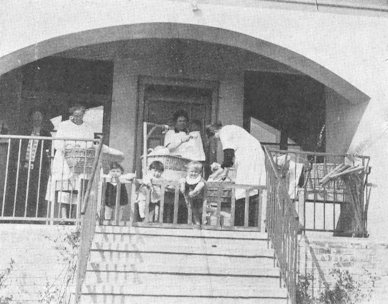
A laboratory in the American Folk School
The American Folk School in the little village of Pordim is trying to prepare the villagers to intelligently, moderately and efficiently play their part in the creation of Bulgaria's future. It is not so much a cog in an educational machine as an apostolic crusade, carried on for the purpose of transforming dull, dissatisfied villagers into wise villagers — and, of course, when that is accomplished most of Bulgaria's problems will be solved. But this is not easy to accomplish and requires patience, heroism, expert knowledge, vast faith, boundless devotion and unwearying energy.
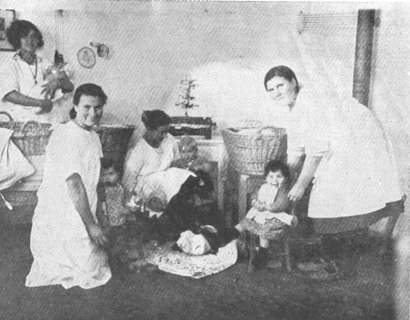
The girls learn how to take care of babies by taking
care of babies
This energy is essential because so much has to be done in so short a time. The course of the school is but one year; indeed it specializes on short courses lasting only a few months. It has to take village youth on the wing and work with them rapidly, keeping them ever close to peasant life. It makes the track over, while the train is running. It teaches the girls to bring up babies by actually keeping a dozen babies the year through. It teaches child training in the kindergarten which it itself maintains. It teaches cooking, house decorating, gardening, dairying, bee raising and the producing of eggs and chickens, by having the pupils do those things. It is a real village. It shows the youth how to do well and happily what they all have to do at home. And with it all, much culture is instilled, a wider view point is given and the youthful "Rubes", along with their awkward sisters are brought into touch with some of the beauty, nobility and politeness of the outside world. A channel is opened up,. bringing the good things of life into limited, grey, thwarted villages. The youth there are made to feel that they, too, are somebodies and that they also on their tiny farms, amid their black buffalo and waddling ducks, may live healthily and agreeably. They are transformed from spiritless fatalists or bitter rebels into hopeful builders of a better tomorrow.
The Folk School was opened in the fall of 1929 by two missionaries of the American Board on land given to them by the village. And as they were looking for a location thirty other villages and towns also urgently offered them spacious sites. The local authorities and the highest state officials, as well as practically all agricultural experts are cooperating most heartily with the new enterprise. Not long after its creation it was transferred to the Near East Foundation, an American educational corporation with very sound ideas as to the kind of educational work needed in Near East lands.
Of course, the Folk School at Pordim is not the only educational institution
in Bulgaria giving agricultural instruction to village youth. The state
itself maintains many good schools for that purpose. What distinguishes
this American enterprise is that it is closer to village life; it has more
verve, a more inspiring sweep; it stimulates more faith, gives a brighter
vision, fills its pupils with a warmer consciousness that they are among
the most essential builders of a better Bulgaria. It is a movement, a crusade,
a drive toward an essential victory. It removes the paralyzing chains of
bureaucracy and institutionalism and fills its pupils with a flaming desire
to rebuild their society from the bottom up — from the village up — and
better still it shows them just how to do it with twelve acres and a few
cows, pigs, chickens and honey bees. As this school is barely in its infancy
its enrollment is still small but it is winning the goodwill and confidence
of the country with extraordinary rapidity and will undoubtedly grow into
a large undertaking.
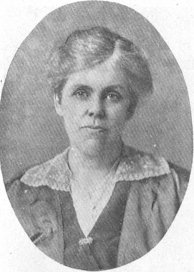 |
 |
| Miss Inez L. Abbott | The Rev. Leroy F. Ostrander |
Many American educators have made signal contributions to the training
of the Bulgarian youth, giving the full measure of devotion, but the first
places among them are held by the late Miss Inez L. Abbott and Rev. Leroy
F. Ostrander, who were for many years the heads of the girls' and boys'
schools at Samokov, the institutions which later moved to Sofia and fused
under the name of the American College. Both of these teachers died comparatively
young and while still in the service. Miss Abbott in her breadth of views,
her wide knowledge of world affairs, her unlimited devotion to Bulgarian
youth, her excellent pedagogical ideals, her genial, friendly spirit and
the winsome attractiveness of her strong, sweet character, always filled
with optimism and hope, attained first rank among all the Americans who
have given their lives to Bulgaria. And a very worthy colleague was Mr.
Ostrander who by his prodigious capacity for work, his boundless patience
with every earnest boy, his utter unselfishness and unflagging pursuit
of all that was good and noble left a light and a fire in his students
which will never be entirely extinguished by any number of years nor by
any press of degrading circumstances.
[Previous] [Next]
[Back to Index]